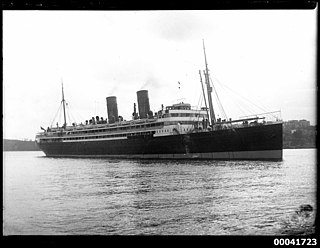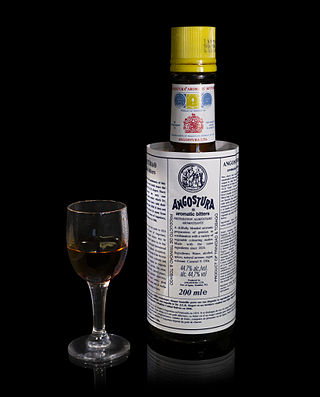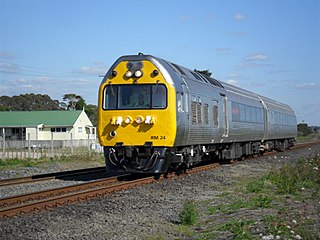
RMS Niagara was a transpacific steam ocean liner, Royal Mail Ship and refrigerated cargo ship. She was launched in 1912 in Scotland and sunk in 1940 by a mine off the coast of New Zealand.

Ōtaki is a town in the Kāpiti Coast District of the North Island of New Zealand, situated half way between the capital city Wellington, 70 km (43 mi) to the southwest, and Palmerston North, 70 km (43 mi) to the northeast.

The House of Angostura, also known as Angostura Limited, is a Trinidad and Tobago company famous for the production of Angostura bitters, invented by the company's founder. The company is also a distiller and is the major producer of rum in Trinidad and Tobago. The company also has been used as a vehicle for international expansion by its parent company, CL Financial. As a result of these acquisitions, the company owns distillers in the United States, Canada, The Bahamas and Suriname.

Angostura bitters is a concentrated bitters based on gentian, herbs, and spices, produced by House of Angostura in Trinidad and Tobago. It is typically used for flavouring beverages, or less often, food. The bitters were first produced in the town of Angostura, hence the name, but do not contain angostura bark. The bottle is recognisable by its distinctive oversized label. Angostura is Spanish for "narrowing", the town of Angostura having been at the first narrowing of the Orinoco River.

The NZR RM class Silver Fern was a class of rail motor in New Zealand. The three air-conditioned and sound-proofed 723-kW 96-seater diesel-electric twin-set railcars were built by Kawasaki under contract with Nissho Iwai of Japan. New Zealand Railways (NZR) classified the railcars as RM (Rail Motor), the same as other railcars, using the Silver Ferns (a national symbol of New Zealand) because of their exterior was made of corrugated stainless steel, like the premier night sleeper train that also ran on the Wellington-Auckland (North Island Main Trunk) route, the Silver Star. The Silver Ferns replaced the three successful Blue Streak railcars on the service.

USS Yukon (AF-9) was an Arctic-class stores ship in service with the United States Navy from 1921 to 1922 and from 1940 to 1946. She was scrapped in 1947.
The following lists events that happened during 1839 in New Zealand.
The Derry Castle was a 1,367 ton iron barque built at Glasgow in 1883, and initially operating out of Limerick, Ireland. She had been registered there on 19 November 1883 by Francis Spaight & Sons. In 1887 while voyaging from Australia to the United Kingdom with a cargo of wheat, she foundered off Enderby Island, in the subantarctic Auckland Islands, on a reef which now bears her name.

Port Albert is situated on the shores of the Kaipara Harbour, approximately 8 kilometres west of Wellsford, in the Auckland Region of New Zealand. Originally called Albertland, it was the last of the major organised British settlements in New Zealand.

James McCosh Clark was Mayor of Auckland City in the 1880s. He was a successful businessman until many of his ventures failed during the depression of the 1880s, causing him to return to England for the last decade of his life. He was the son of Archibald Clark.
Philip Laing is a 19th-century sailing ship best known as the second immigrant ship to arrive in Dunedin, New Zealand, on 15 April 1848. Chartered by the New Zealand Company for this voyage the ship was carrying Scottish settlers, under the charge of the Rev. Dr. Thomas Burns.
Sebastopol was a New Zealand immigrant clipper ship of 992 tons, built in New Glasgow, Nova Scotia, Canada. She made two voyages to New Zealand in 1861 and 1863 sailing from Gravesend, England to Lyttelton, Christchurch with immigrants for the Canterbury Provincial Government.
Victory was built by Fenwick & Co, Sunderland in 1847 and owned by Willis, Gunn and Co and later owned by Wilson and Cook. She was a 578- or 579-ton barque that brought some of the first immigrants from England to Dunedin in July 1848. She also called at Wellington, New Zealand, in August 1848. There was an advertisement that gave her weight as 700 tons, but, given that her captain in 1851 was Mullens, it was unlikely to be another ship.

The New Zealand Company was a 19th-century English company that played a key role in the colonisation of New Zealand. The company was formed to carry out the principles of systematic colonisation devised by Edward Gibbon Wakefield, who envisaged the creation of a new-model English society in the southern hemisphere. Under Wakefield's model, the colony would attract capitalists who would then have a ready supply of labour—migrant labourers who could not initially afford to be property owners, but who would have the expectation of one day buying land with their savings.
Lord William Bentink was launched in 1828 at Yarmouth. She made one voyage transporting convicts to Tasmania, and three carrying settlers to New Zealand for the New Zealand Company. She was wrecked between 1858 and 1859.
The wreck of the three-masted ship Surat, on New Year's Day 1874, was a major event in the early history of New Zealand's Otago Region.

SS Otaki was a New Zealand Shipping Company refrigerated cargo steamship that was built in Scotland in 1908 and sunk by a German merchant raider in 1917.

SS Rotorua was a New Zealand Shipping Company steam ocean liner and refrigerated cargo ship that was built in Scotland in 1910 and sunk by a U-boat in 1917.












